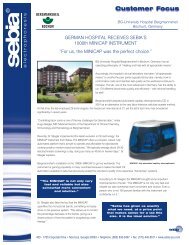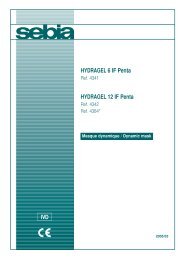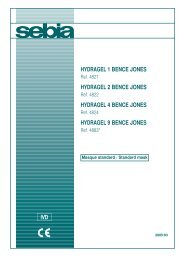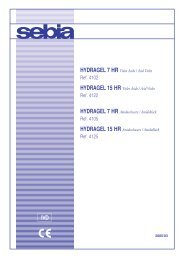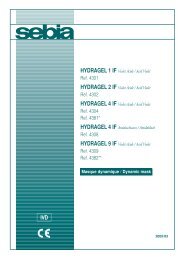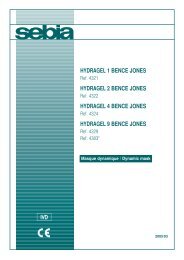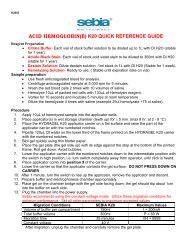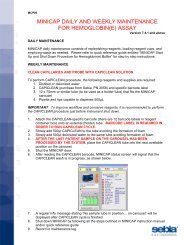HYDRAGEL HEMOGLOBIN(E) K20
HYDRAGEL HEMOGLOBIN(E) K20 - Sebia Electrophoresis
HYDRAGEL HEMOGLOBIN(E) K20 - Sebia Electrophoresis
- No tags were found...
Create successful ePaper yourself
Turn your PDF publications into a flip-book with our unique Google optimized e-Paper software.
<strong>HYDRAGEL</strong> <strong>HEMOGLOBIN</strong>(E) <strong>K20</strong> - 2005/03<br />
RESULTS<br />
Quality Control<br />
It is advised to include an assayed control blood or assayed blood sample containing hemoglobins A, F, C and S into each run of samples.<br />
Values<br />
Densitometer scanning of stained electrophoregrams yields relative concentrations (percentages) of individual hemoglobin zones.<br />
Normal values (mean ± 2 SD) using <strong>HYDRAGEL</strong> <strong>HEMOGLOBIN</strong>(E) <strong>K20</strong> procedure have been established from a healthy population of 200 adults<br />
(men and women):<br />
Hemoglobin A ≥ 96.5 %<br />
Hemoglobin F < 2.0 % (*)<br />
Hemoglobin A 2<br />
≤ 3.5 %<br />
(*) see Interference and Limitations<br />
It is recommended each laboratory establishes its own normal values.<br />
Interpretation<br />
1. Qualitative abnormalities: Hemoglobinopathies<br />
Most hemoglobinopathies are due to substitution by mutation of a single amino acid in one of the four types of polypeptide chains. The clinical<br />
significance of such a change depends on the type of amino acid and the site involved. In clinically significant disease, either the α-chain or the<br />
ß-chain is affected (even γ chains).<br />
More than 200 variants of adult hemoglobin have been described. The first abnormal hemoglobins studied and the most frequently occuring have an<br />
altered net electric charge, leading to an easy detection by electrophoresis.<br />
There are four main abnormal hemoglobins which present a particular clinical interest: S, C, E and D.<br />
The <strong>HYDRAGEL</strong> <strong>HEMOGLOBIN</strong>(E) <strong>K20</strong> kits are intended for the preliminary identification of hemoglobinopathies and thalassemias. Once an<br />
abnormal pattern is indicated, its identity should be confirmed by appropriate discriminatory tests (e.g., electrophoresis on acidic agarose gels).<br />
Hemoglobin S<br />
Hemoglobin S is the most frequent. It is due to the replacement of one glutamic acid (an acidic amino acid) of the ß-chain by valine (a neutral amino<br />
acid). Its electrophoretic mobility is therefore slowed down. On alkaline buffered gels, <strong>HYDRAGEL</strong> <strong>HEMOGLOBIN</strong>(E) <strong>K20</strong>, hemoglobin S migrates<br />
between A and A 2<br />
fractions.<br />
Hemoglobin C<br />
One glutamic acid of the ß-chain is replaced by lysine (a basic amino acid): its mobility is strongly reduced. With <strong>HYDRAGEL</strong> <strong>HEMOGLOBIN</strong>(E) <strong>K20</strong><br />
procedure, C, E and A 2<br />
are superimposed. When this fraction is > 15 %, hemoglobins C and E must be suspected.<br />
Hemoglobin E<br />
One glutamic acid of the ß-chain is replaced by lysine: hemoglobin E migrates exactly like hemoglobin C using <strong>HYDRAGEL</strong> <strong>HEMOGLOBIN</strong>(E) <strong>K20</strong><br />
procedure. Unlike hemoglobin C, it does not separate from hemoglobin A in acidic buffer [<strong>HYDRAGEL</strong> ACID(E) <strong>HEMOGLOBIN</strong>(E) <strong>K20</strong>]. This property<br />
allows to differentiate E and C.<br />
Hemoglobin D<br />
One glutamic acid of the ß-chain is replaced by glutamine. With <strong>HYDRAGEL</strong> <strong>HEMOGLOBIN</strong>(E) <strong>K20</strong> procedure, this hemoglobin migrates exactly like<br />
hemoglobin S. Hemoglobin D does not separate from hemoglobin A in acidic buffer [<strong>HYDRAGEL</strong> ACID(E) <strong>HEMOGLOBIN</strong>(E) <strong>K20</strong>] ; this property allows<br />
to differenciate S and D.<br />
2. Quantitative abnormalities: Thalassemias<br />
Thalassemias constitute a quite heterogeneous group of genetic disorders characterized by decreased synthesis of one or several types of the<br />
polypeptide chains. The molecular mechanism of this decrease has not been fully described.<br />
There are two types of thalassemia syndromes:<br />
Alpha-thalassemias<br />
They are characterized by the decrease of synthesis of the α-chains, consequently affecting the synthesis of all normal hemoglobins.<br />
The excess of synthesis of the ß- and γ-chains in relation to α-chains chains induces the formation of tetrameres without any α-chain:<br />
• hemoglobin Bart = γ 4,<br />
• hemoglobin H = ß 4.<br />
Beta-thalassemias<br />
They are characterized by the decrease of synthesis of the ß-chains. Only hemoglobin A synthesis is affected.<br />
Therefore hemoglobin F and hemoglobin A 2<br />
percentages are increased with respect to hemoglobin A.<br />
3. Migration patterns<br />
Migration of normal<br />
hemoglobins<br />
A(A 0<br />
+ A 1<br />
) A (A 0<br />
+ A 1<br />
)<br />
F<br />
S - D<br />
A 2<br />
A 2<br />
- C - E<br />
carbonic anhydrase<br />
carbonic anhydrase<br />
Migration of major abnormal<br />
hemoglobins<br />
application point<br />
A 0<br />
: The non-glycated fraction of the normal adult hemoglobin A.<br />
A 1<br />
: The glycated fraction of the normal adult hemoglobin A.<br />
In the above patterns, the cathode is at the bottom the anode at the top.<br />
- 12 -




